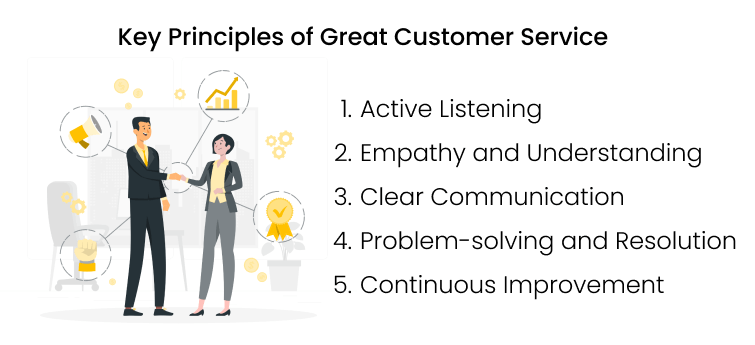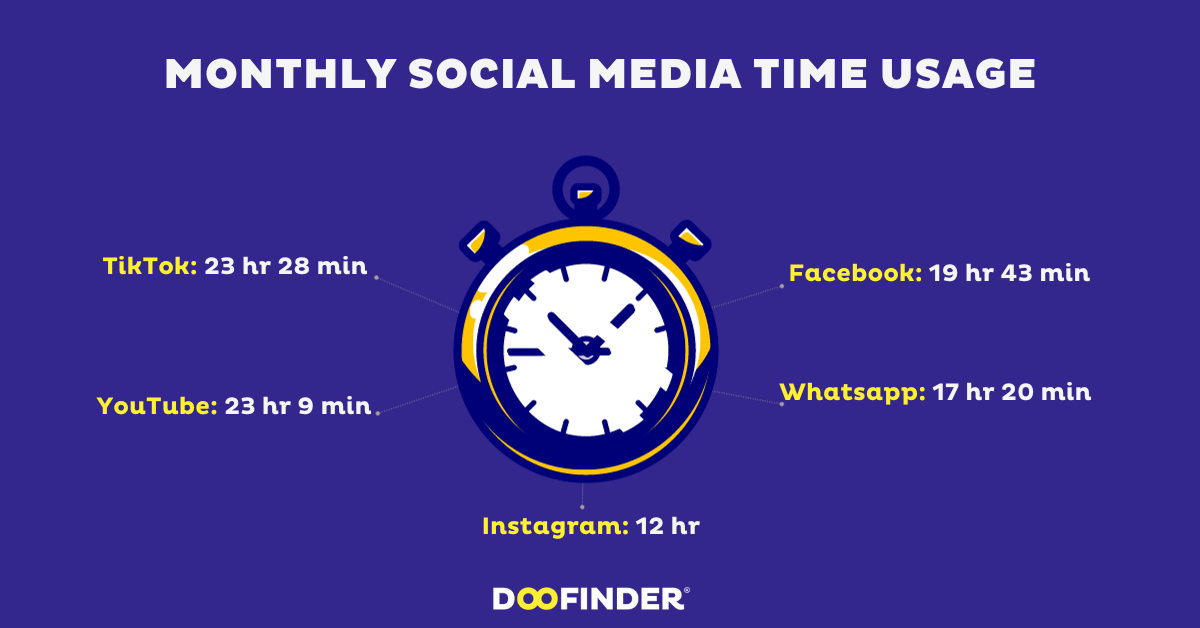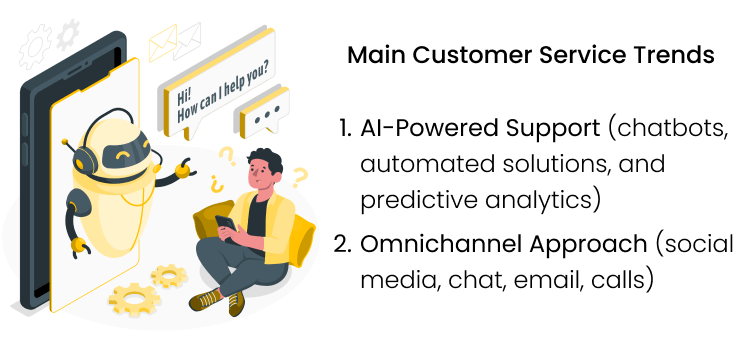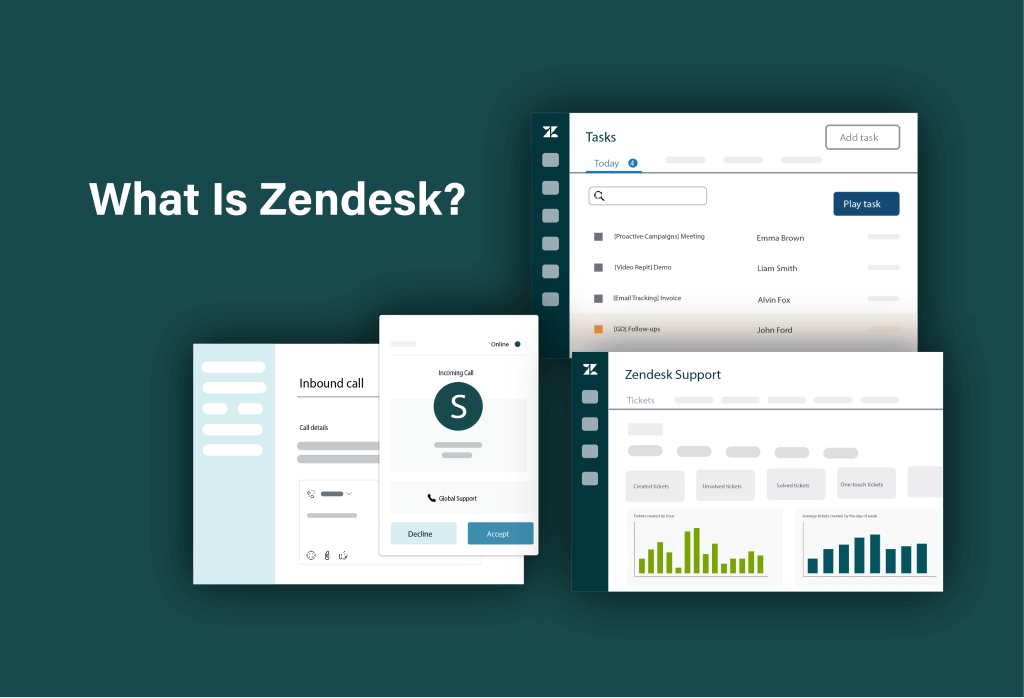Outstanding customer service starts with simply understanding its fundamentals, components, pillars, and, of course, pitfalls. Keep reading to explore this complex interplay of customer service core elements in simple terms.
Definition and Importance of Customer Service
Let's start with the basics that probably many don't even consider. So, what does customer service mean?
What is customer service?
Customer service refers to the company's continuous assistance to clients throughout their interaction, from pre-purchase inquiries to post-purchase support, aiming to enhance their overall buying experience.
Actually, it's a challenge to define customer service in just one sentence. However, in general, this description includes all the main touch points that give us a clear idea of what customer service is.

Why is customer service important for businesses?
At the same time, it's much easier to explain the importance of customer service as it’s an anchor of any successful business. It's about more than just good communication and quick problem-solving. Exceptional customer service is the ultimate force behind long-term success.
The research conducted by Zendesk states that 81% of customers are more likely to make another purchase if they have a positive customer service experience with a company.
Beyond sales growth, it builds trust and connection with the audience and opens doors to invaluable feedback, allowing businesses to evolve and improve continuously.
In today's interconnected world, where word-of-mouth spreads rapidly through social media and online reviews, positive customer experiences can enhance a company's reputation. That’s why prioritizing customer service is an investment in a business's growth and sustainability.
How Customer Service Works
Whether your company deals in groceries, apps, furniture, or high-tech gadgets, the approach to customer service follows a similar pattern. It starts with a dedicated support team communicating through different channels to assist customers at every step – before, during, and after their purchase journey (customer onboarding).
Whether it's a phone call, an email, a live chat, or interactions on social media platforms, people use these channels to seek help, answers, or recommendations. Thus, customer service acts as a bridge between customers and the company by effectively helping and resolving their problems or complaints.
The Evolution of Customer Service
Historical Perspective
Customer service isn't just a modern concept — it has roots that go way back.
Imagine those ancient markets filled with traders and buyers haggling face-to-face. That was the earliest form of customer interaction. But as time passed, so did the ways companies connected with their customers.
Fast forward to the Industrial Revolution. Suddenly, quality and customer satisfaction became a big deal. Businesses started to focus not just on making stuff but also on keeping customers happy.
Then, at the dawn of the 20th century, a game-changer arrived: phone support and those iconic mail-order catalogs. Companies could now reach customers even if they lived miles away.
Then, the digital era started, and that's where it got wild!
Technological Advancements and Their Impact
The 21st century has had the biggest impact on the customer experience. It has completely reshaped the way businesses connect with their clients.
1. Introduction of Computers
The first step of this revolution was the advent of computers. Suddenly, data could be stored, processed, and accessed at lightning speeds, allowing companies to process orders and track customer histories faster and more efficiently.
2. The Internet Boom
Then, the Internet came into play. It was like opening a floodgate of possibilities. Companies established their online presence through websites, opening virtual doors for customers worldwide.
3. Mobile Revolution
But hold on tight because the mobile revolution wasn't far behind! With the rise of smartphones, customer service has become pocket-sized. Customers could connect on the go, access support, and submit queries or complaints with just a few taps on their screens.
4. AI and Automation
Now, let's welcome the stars of the show: Artificial Intelligence and Automation. These technological marvels have changed the dynamics of customer service.
AI-powered chatbots handle routine queries at any time of the day or night, offering lightning-fast responses and freeing up humans to solve more complex problems. Machine learning algorithms can easily analyze vast amounts of data to predict customer needs and personalize interactions, adding that extra touch of tailored support.
Key Principles of Great Customer Service
Technologies and new developments, indeed, turned customer service upside down. Nevertheless, some key principles remain the same to ensure a memorable customer experience.

Active Listening
It's not just hearing. It's really tuning in. When you listen actively, you're not just catching words but also understanding needs. It's like giving customers the spotlight and making them feel heard.
Empathy and Understanding
Now, everyone is striving for understanding. In the interview, Shep Hyken, a CX expert, emphasized the importance of empathy for all customers.
Imagine stepping into their shoes and feeling what they feel. It's the secret sauce that can create a special connection. When clients know you've got it, magic happens.
Clear Communication
No jargon, no confusing stuff — just plain and simple words. Think of it like having a chat with your favorite person. Crystal-clear communication is the highway to mutual understanding.
Problem-solving and Resolution
No words are needed to explain the weight of quick problem resolution for superior customer service. Clients always remember how you handled the tough times more than the smooth ones. So when issues arise, it's time to put on that cape to dive into customer context and find solutions. Also, you need to keep track of your teams' ticket resolution time and consistently perform actions to reduce this indicator.
Continuous Improvement
Have you ever heard the phrase "evolve or dissolve"? Well, in the world of customer service, it's all about evolution. Continuous improvement means staying on your toes. It's not admitting defeat but embracing growth. Listen to feedback — both the praise and the critique — learn from it, and then level up.
Bad Customer Service: Recognise and Avoid
To make your customer service management strategy better, start with the opposite. You must determine what is wrong with an approach considered bad.
Recognizing poor customer service is the first and very important step. First, look at the key principles of great customer service listed above. If any of these are missing, keep that in mind.
Also, collect all types of possible feedback to identify your weak points. And then do your best to avoid them at all costs.
Main Components of Customer Service
Now, it’s time to see what customer service consists of. What are these pillars that form the bedrock of exceptional experiences?
Listening and Communication Skills
Remember, listening is more than just hearing. Communicating is more than just talking. These skills should be on a much deeper level (especially for virtual communication). That’s about a pure connection between the company and the customers, making them feel understood and valued.
Empathy
A study conducted by Dixa shows that 96% of consumers consider empathy a very important quality for customer service representatives. Are you ready to disappoint 96% of your clients?
Guess, no.
By showing genuine empathy, your agents can show that they truly care. As a result, you get satisfied, loyal customers and long-term relationships with them.
Knowledge & Competence
Be the expert in your field. Clients rely on your competence. It is the only way to gain trust, a good reputation, customer referrals, and retention.
Problem-Solving
We’ve already mentioned this point. But it never hurts to highlight what problem-solving skills can do for your business. In most cases, the reason for customer requests is some kind of question or problem. And they are waiting for your answer or solution as soon as possible.
Patience
Stay calm even during the strongest storm.
Working with people may not always be smooth sailing, but patience must outpace your emotions. Even when things get hectic, make sure everyone feels heard and respected.
Responsiveness
Have you ever received an immediate, competent answer to your request? It’s a priceless experience in our fast-paced world. Responsiveness is the art of showing customers they’re a priority, ensuring their needs are met promptly.
Feedback Collection
There is no way your company can exist without collecting and analyzing feedback. With survey stats and responses, you have customer service guidelines in your hands. Use these metrics to maintain your assistance at the highest level.
Training & Development
Consider training an ongoing journey. Our world is changing every single day, and your customer support team should keep up. Continuous learning (books, blogs, courses) and development will yield results in providing first-class service.
Technology & Tools
Be bold and take full advantage of the digital age. From chatbots to databases, they're all designed to reduce the time and effort of routine tasks and bring more effectiveness to your team's performance.
Adaptability
Customer service representatives encounter customers with varied needs, preferences, and communication styles daily. Adaptability allows the support team to tailor its approach to each individual, embrace change, learn new tools or processes, and adjust methods to the latest trends.
Consistency
Find a field where consistency isn’t a thing. In customer service, it also works wonders. Keep your work and interactions stable to create a standard that clients can rely on, ensuring each experience is as outstanding as the last.
Teamwork & Collaboration
Team members are not separate units but gears of one complex mechanism. Therefore, they must be responsible for running smoothly by collaborating and sharing knowledge and ideas. And this doesn't just apply to the support team inside. It should be a collaboration with the sales department, marketing teams, developers, etc.

Proactivity
The ability to predict and anticipate customer needs before they arise is the key to success. Overall, proactivity in customer service is about being one step ahead, showing genuine care, and consistently exceeding customer expectations.
Recognition & Reward
Keep your team motivated by recognizing and rewarding exceptional service. Noticing weaknesses is just as important as celebrating small and big wins. It boosts morale, inspires, and encourages the team to aim higher.
13 Different Types of Customer Service
Now that we've covered the basics, let's take a closer look at the different methods businesses use to provide timely and effective assistance.
Live Telephone Support (Inbound & Outbound)
It's probably not the most modern type of customer service, but it's still strong in the market, especially when you've got a pressing issue that needs a quick solution.
Companies provide live telephone support to handle incoming calls from customers seeking assistance (inbound) or to reach out to customers for various reasons (outbound).
Email Marketing (Support)
Emails aren't just for promotions or cold messaging anymore. They can offer clients guidance or assistance. And that's email support in action. Companies use email not only to market but also to respond to customer queries and provide solutions. It's like a direct line to customer support in your inbox.
Live Chat Support
Another way to connect with support agents in real-time is through live chat support. This instant messaging tool gives customers the feeling of ongoing assistance and 24/7 support.
Social Media Support
With the high rise in social media popularity, customer service cannot stand on the sidelines. The study shows that people spend an average of 19 hours and 43 minutes monthly on Facebook alone. Thus, businesses use social media channels to meet audiences in places where they already spend time.

Self-Service
Let your customers find answers without contacting support. Websites should host FAQs, troubleshooting guides, or self-help resources to find solutions independently. It empowers customers to resolve issues at their convenience without the need for direct interaction.
Ticketing System Support
Any service works better when it’s organized. With the ticketing system support, you will forget about lost or forgotten customer queries. This system acts as a centralized hub that collects all requests and groups them into tickets, which are categorized, tagged, and prioritized based on the urgency or nature of the issue.
Technical Support
Is there a problem with the gadgets or software? Technical support comes to the rescue. Companies provide technical assistance to troubleshoot and resolve issues related to hardware, software, or other technical difficulties. They guide customers through solutions step by step.
Field Service (On-site Support)
Sometimes, issues can't be solved remotely. Field service involves technicians or experts visiting a customer's location to address complex or hands-on problems. Whether installing, repairing, or maintaining equipment, they bring the support right to the front door.
Community Support (Forums & User Groups)
Communities of users often gather on forums or user groups related to a product or service. These spaces allow users to share experiences, exchange tips, and help each other. Sometimes, companies facilitate these spaces, ensuring users receive peer-to-peer support even when the company isn't directly involved.
Knowledge Base or FAQ Support
As an integral part of the self-service system and a separate tool, the knowledge base and FAQ can provide many answers. These resources are like a library filled with valuable information to guide customers through common queries, troubleshoot steps, or provide detailed product or service descriptions.
Proactive Customer Support
Imagine getting tips or updates from a company before you even realize you need them. Proactive support involves companies taking the lead by providing information, updates, or solutions before customers ask for them. It's all about foreseeing needs and providing assistance in advance.
eCommerce Customer Service
Shopping online and got questions? eCommerce customer service ensures that the entire online shopping experience — from browsing to checkout — is smooth and hassle-free.
GDPR Compliance for Customer Service
In the era of data privacy, companies adhere to GDPR (General Data Protection Regulation) tools and rules when handling customer data. That is a responsible approach to data processing, safeguarding customer information, and respecting privacy rights.
To keep up with these standards, GrowthDot developed the GDPR Compliance app for Zendesk to anonymize, delete, and retrieve data quickly.
The Most Popular Customer Service Tools
Having the right tools at your disposal can make a big difference in managing all the systems and practices mentioned above. That's why we are revealing the best software solutions, apps, and other instruments that have become essential to modern businesses in their quest to provide top-notch customer service.
1. Ticketing and Help Desk Platforms
Here's the top available options:
Zendesk Support
A robust platform offering ticketing, live chat, and knowledge base functionalities. Zendesk Support assists across multiple channels like email, chat, phone, social media, and more, ensuring a seamless customer experience. For agents, there are options to set up various automations and triggers to streamline repetitive tasks.
Moreover, Zendesk supports so many different applications and integrations that it can take time to choose from.
Freshdesk
Known for its user-friendly interface and omnichannel support, Freshdesk consolidates requests from multiple sources, allowing teams to manage customer queries efficiently. It is a cloud-based platform with automated workflows, collaboration tools, and integration capabilities.
Help Scout
This software focuses on providing personalized, email-based support. By providing a shared inbox for managing customer emails, Help Scout enables collaborative handling of customer requests and gives a cohesive view of the whole conversation.
2. Live Chat Software
Here's the top available options:
Intercom
Offers real-time engagement tools, enabling businesses to interact with visitors on their website through chat and targeted messaging. Intercom brings together salespeople, support agents, and the marketing team to maximize the company’s growth and productivity.
LiveChat
Specializes in live chat solutions to provide immediate assistance to website visitors. With LiveChat, you get a suite of chat tools that support multiple message channels and offer customization options to add personal touch to basic customer interactions.
Tawk.to
It's an app that offers basic live chat functionalities to interact with customers and provide immediate assistance. In Tawk.to, you can track real-time activity and overall customer journey to gain valuable insights for your future successful strategy. And the best part is that it's completely free.
3. Knowledge Base and Self-Service
Here's the top available options:
Confluence
Confluence is a collaboration software developed by Atlassian. It is primarily designed for creating, organizing, and sharing content within your teams. Confluence is a centralized platform for documentation, knowledge management, and project collaboration.
Enables companies to create comprehensive help centers with FAQs, guides, and tutorials, empowering customers to find solutions independently. Additionally, Zendesk Guide offers customization options to match your knowledge base with company branding and translation options to suit any global audience.
ProProfs Knowledge Base
It aims to assist businesses in creating and sharing various knowledge resources (articles, FAQs, and documentation). ProProfs Knowledge Base offers a range of features tailored to streamline the creation and accessibility of information for customers.
4. CRM (Customer Relationship Management) Systems
Here's the top available options:
Salesforce
A powerful CRM system managing customer data, fostering customer relationships, and offering extensive customization and integration options. Salesforce provides a suite of products and solutions, including Sales Cloud (for sales automation), Service Cloud (for customer service), Marketing Cloud (for marketing automation), Commerce Cloud (for e-commerce), and more.
HubSpot CRM
Integrates sales, marketing, and service functionalities, providing a unified platform for customer interactions and relationship management. HubSpot is popular for its simple in-use design and the ability to scale with businesses of different sizes.
Microsoft Dynamics 365
An integrated suite of applications that offers sales, customer service, field service, marketing, finance, and operations capabilities. Keeping up with the world, Microsoft Dynamics 365 incorporates AI and analytics capabilities to provide insights, predictions, and intelligent recommendations across various business functions.
The app is tailored to easily manage leads and deals with a streamlined system across Zendesk. A comprehensible and fully customizable dashboard gives a clear grasp of the entire sales funnel in your company. Take advantage of built-in statistics and forecasting tools to stay on track with real-time deals and predict future performance for a successful strategy.
5. Call Center Software
Here's the top available options:
Aircall
Aircall operates entirely in the cloud, allowing users to access the platform from anywhere with an internet connection, promoting flexibility and remote work. It has call management features like call routing, queuing, and forwarding. With Aircall, you get reporting tools to track call metrics, measure call performance, and gain insights into call volume, duration, and response times.
RingCentral
This software provides a range of services, including voice, video, messaging, and conferencing solutions to improve company communication and productivity. By installing the Ring Central mobile app, users can access all their communications tools on the go and stay connected at all times.
Five9
Five9 is an omnichannel customer engagement solution. It can handle inbound calls, outbound dialing, call routing, and interactive voice response (IVR). Moreover, this software offers intelligent call routing and skills-based routing to connect customers with the most suitable agent based on skills, availability, and customer needs.
6. Social Media Management Tools
Here's the top available options:
Hootsuite
This social media management platform allows users to manage multiple social media accounts (such as Facebook, X, Instagram, LinkedIn, and more) from one centralized hub. With Hootsuite, you can create, discover, share, and schedule different types of interesting content. You can then track social media performance, measure key metrics, and analyze reports.
Buffer
A tool created to simplify the process of scheduling, publishing, and analyzing content across various social media platforms. Buffer’s advantages include an accessible browser extension and a visual calendar that makes planning, organizing, and managing posts across different dates and channels easy.
Sprout Social
Another great platform that helps companies manage their social media presence, engage with the audience, and analyze their performance. Sprout Social monitors social media mentions, keywords, and hashtags, helping users track brand mentions and the latest industry trends.
7. Chatbots and AI Assistants
Here's the top available options:
Drift
Offers conversational marketing and sales solutions, including live chat and chatbots, to increase customer engagement and lead generation. Drift focuses on promoting real-time conversations with the help of AI-powered chatbots that can interact with users, answer common queries, and guide website visitors through predefined workflows.
ManyChat
It’s a popular chatbot platform that enables businesses to create and deploy chatbots on various messaging platforms, primarily focusing on Facebook Messenger. Companies can easily create, design, and customize chatbots using the visual flow designer and automate customer interactions.
IBM Watson Assistant
IBM has developed an AI-powered virtual assistant platform that helps build and deploy chatbots and virtual assistants across multiple channels. The main feature of IBM Watson Assistant is its ability to use natural language processing (NLP) to understand and interpret user queries easily.
8. Feedback and Survey Tools
Here's the top available options:
SurveyMonkey
This online survey platform allows individuals and businesses to create, distribute, and analyze surveys to gather customers' feedback, opinions, and data. With SurveyMonkey, you also get ready-made survey templates and access to a question bank with commonly used survey questions that streamline the creation process.
Typeform
In addition to typical surveys, Typeform allows users to create interactive and user-friendly forms, quizzes, and questionnaires. Various customizable features for adding brand identity through images, videos, and themes make it a popular choice for creating visually appealing and interactive forms and surveys.
For Zendesk users, there is an integration with a simple interface to collect customer feedback at any stage of request processing. The NPS and Survey app offers companies an unlimited supply of four survey types, branding and translation options, trigger customization, and a full reporting and statistics overview.
9. Analytics and Reporting
Here's the top available options:
Google Analytics
Considered one of the most dominant and comprehensive web analytics platforms, Google Analytics is popular among businesses of all sizes, ranging from small enterprises to large corporations. It is a powerful tool that helps companies and website owners optimize website performance, understand user behavior, and improve the overall user experience. Even though it has an extensive list of features and ease of use, it remains free for most users.
Zendesk Explore
One more tool offered by Zendesk to provide in-depth insights and visualizations into customer service and support data. Companies use Zendesk Explore to create personalized dashboards with drag-and-drop functionalities to visualize essential metrics and KPIs related to customer service performance.
The integration with other Zendesk services and apps will give you a seamless ecosystem to increase efficiency, facilitate collaboration, and enable companies to make data-driven decisions to satisfy every customer’s needs.
Customer Service for Different Seasons
In the world of customer support, time also exists, so there are different seasons and holidays with their unique challenges. Accordingly, your team should do the spadework.
The demands shift dramatically during peak periods like holidays, tax seasons, or back-to-school rushes. For instance, during the Christmas bustle, there is always a high rise in customer inquiries, purchases, and support requests. Therefore, companies must prepare by extending operating hours, offering promotions, and ensuring timely responses to address the heightened demands.
Each season has its own peculiarities:
- Holiday Season: increased traffic, higher customer requests.
- Tax Season: queries about financial matters, urgency in response, and potential sensitivity in customer interactions.
- Back-to-School Season: time-sensitive demands regarding school supplies, educational resources, or subscription services.
- Summer Vacation: customer needs towards travel bookings, vacation-related inquiries, or leisure activities.
- Off-Peak or Low Season: decreased customer inquiries and orders, potential dips in engagement or sales. P.S. Great opportunity to focus on proactive customer outreach, retention strategies, and product development in preparation for the busy seasons ahead!
Keep these challenges in mind to develop your team’s customer service skills and sales strategies in line with the current season.
Main Customer Service Trends
Every year brings fresh tech, marketing fashions, innovations, and tendencies. Staying ahead in customer service demands keeping pace with these evolving landscapes.

So, we picked out for you two main current trends in the customer service field:
- AI-Powered Support. Undoubtedly, artificial intelligence is the biggest breakthrough of the last time that revolutionized the way we run a business. Chatbots, automated solutions, and predictive analytics streamline quick, personalized issue resolution and customer interaction.
- Omnichannel Approach. You no longer have to worry about choosing the right preferred channel. The latest software tools allow you to leverage multiple touchpoints (social media, chat, email, calls) and deliver a unified, seamless customer journey and consistent support.
To Wrap Up
As you’ve understood, customer service is the foundation of a company’s success.
After learning all the information about its history, key elements, market trends, main components, different types, features, and technical tools, you are fully equipped to conquer the loyalty and admiration of your customers and ensure the prosperity of your business.
Customer Service FAQs
What is the definition of customer service?
Customer service is ongoing support, assistance, and guidance provided by the company to elevate and refine the overall customer experience throughout the entire interaction.
What are the 3 important qualities of customer service?
Delivering exceptional customer service hinges on several fundamental qualities mentioned above. Among these, three stand out as the most essential principles:
- Empathy: customer support managers can understand customers' emotions and needs and relate to them with genuine care and concern.
- Problem-solving skills: the ability to address issues efficiently, offering solutions that satisfy customers and resolve their concerns successfully.
- Effective communication: Clear, concise, and attentive communication, ensuring customers feel heard, understood, and well-informed.
What is good customer service, in simple words?
Good customer service means offering helpful, attentive support that meets customers' needs, leaving them satisfied and valued after interacting with a company. It does not necessarily include purchasing or closing the deal with a customer. While sales are a part of the process, successful customer service prioritizes a positive customer experience over immediate transactions.












